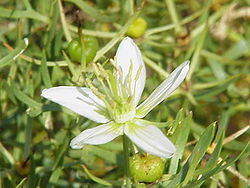| Nitrariaceae | |
|---|---|
 | |
| Peganum harmala | |
| Scientific classification | |
| Kingdom: | Plantae |
| Clade: | Tracheophytes |
| Clade: | Angiosperms |
| Clade: | Eudicots |
| Clade: | Rosids |
| Order: | Sapindales |
| Family: | Nitrariaceae Lindl. [1] |
| Genera | |
| |
Nitrariaceae is a family of flowering plants in the order Sapindales. It comprises four genera, Malacocarpus , Nitraria , Peganum and Tetradiclis , totalling 19 species. [2]
The family's main range is in the arid and semi-arid regions from Central Asia west to North Africa and southern Europe, but there are also species in eastern Mexico and southern Australia. [3]